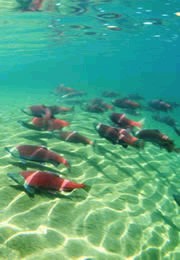|
Environmentalists fear that the accumulation of these compounds, called polychlorinated biphenyls (PCBs), could have harmful consequences for the region's top carnivores: bears, eagles - and humans.
Each summer, millions of sockeye salmon (Oncorhynchus nerka) make the 1,000-km trip from the North Pacific back to the lakes where they were born. After spawning there, they die, and their carcasses decompose in the lakes' sediment.
The fish arrive loaded with PCBs from their oceanic feeding grounds, report Jules Blais of the University of Ottawa, Canada, and his colleagues. In the sediment of lakes with the most returning salmon, such as Frazer Lake on Kodiak Island in southern Alaska, PCB concentrations can be seven times those in lakes that receive no fish.
The results are akin to having a waste incinerator in Alaska's wilderness - pollution levels are as high as those in Lake Superior, close to the heavily populated northeastern United States. "This is a remote, pristine environment, but with PCB deposition comparable to an industrial site," says Blais.
Salmon cart chemicals - good and bad - upstream, agrees ecologist David Schindler of the University of Alberta, Canada. Dying fish, for example, furnish the lakes with vital nutrients. "If they can transport nutrients, they can also transport things that are not quite so beneficial," Schindler says.
Vicious circle
The problem is bioaccumulation - the build-up of contaminants in creatures at the top of the food chain. The North Pacific contains about 1 nanogram of PCBs per litre. By the time the average salmon has finished bulking up for its journey, its fat contains about 160 micrograms, Blais and co-workers report.
"The salmon are perfectly fine for eating," says Blais. But dead fish become fodder for insects at the bottom of the food chain, triggering a fresh round of bioaccumulation. "There's a snowball effect," Blais explains.
PCBs are released into the environment by the manufacture of materials such as flame-retardants and paints, and by burning waste. Their effects on human health are not clear, but are thought to include reproductive defects, memory impairment and reduced hand-eye coordination. PCBs break down very slowly, so they can spread widely and be difficult to track.
“This could turn out to be one of the few environmental problems that we have dealt with in good time” David Schindler - University of Alberta
A case in point is Lake Laberge in Canada's Yukon Territory. In the early 1990s, PCB pollution - thought to have arrived by air from Eurasia - reached such a level that the inhabitants of this otherwise pristine area were warned not to eat trout from the lake. "PCBs have a way of producing surprises," says Blais.
The situation may improve in the future, Schindler predicts. Industrial PCB emissions have been falling for more than 20 years. "This could turn out to be one of the few environmental problems that we have dealt with in good time."
Reference 1
Krümmel, E. M. et al. Delivery of pollutants by spawning salmon. Nature, 425, 255 - 256, (2003). |Article|
Nature 425, 255 - 256 (18 September 2003); doi:10.1038/425255a
Abstract shown below
Aquatic ecology: Delivery of pollutants by spawning salmon
E. M. KRÜMMEL*, R. W. MACDONALD†, L. E. KIMPE*, I. GREGORY-EAVES*, M. J. DEMERS*, J. P. SMOL‡, B. FINNEY§ & J. M. BLAIS*
* Department of Biology, University of Ottawa, Ottawa, Ontario K1N 6N5, Canada
† Institute of Ocean Sciences, Department of Fisheries and Oceans, Sidney, British Columbia V8L 4B2, Canada
‡ Paleoecological Environmental Assessment and Research Laboratory, Department of Biology, Queen's University, Kingston, Ontario K7L 3N6, Canada
§ Institute of Marine Science, University of Alaska Fairbanks, Fairbanks, Alaska 99775, USA
e-mail: jblais@science.uottawa.ca
Pollutants are widely distributed by the atmosphere and the oceans. Contaminants can also be transported by salmon and amplified through the food chain. Here we show that groups of migrating sockeye salmon (Oncorhynchus nerka) can act as bulk-transport vectors of persistent industrial pollutants known as polychlorinated biphenyls (PCBs), which they assimilate from the ocean and then convey over vast distances back to their natal spawning lakes. After spawning, the fish die in their thousands — delivering their toxic cargo to the lake sediment and increasing its PCB content by more than sevenfold when the density of returning salmon is high.
Top
|
